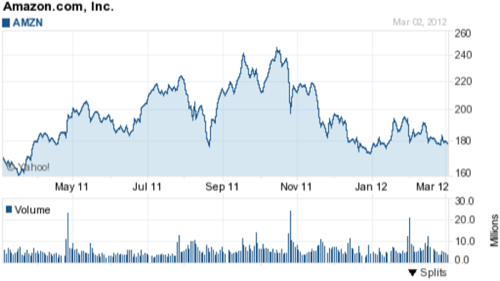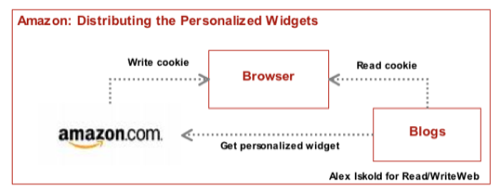We have written here extensively about emerging Amazon Web Services, as well as the latest consumer facing innovations at the world’s largest online retailer. Amazon has consistently delivered exciting technologies, particularly in the last few years. The Web Services play, for example, first caused some puzzlement on Wall Street – but they’ve since upgraded the Amazon stock.

In another recent post we discussed recommendation engines and spent time dissecting Amazon’s recommendation techniques. There is little doubt that Amazon’s recommendation system is the foundation of Amazon’s consumer strategy. Their front page is nothing but a showcase of these different recommendation algorithms: buy things you just clicked on, buy things other people who clicked on this bought, etc.
In this post we look at Amazon’s attempt to take their recommendation system on the road – into the blogosphere. Most people refer to this as widgetizing content, but in typical Amazon fashion they are calling it something different – “linking options”. It is part of the Amazon Associates offering. Specifically what we discuss below is “Omakase Links” [Ed: where does Amazon come up with these names?!], where “you can allow Amazon to recommend products to your site visitors”.
Amazon stock on the rise again after recent innovations

The Idea: Widgetize recommendations
The idea itself is quite simple – leverage Amazon consumer information to offer a set of recommendations anywhere online. This is quite different from standard Amazon banners and links that have been around for a while. Those things are static and not personalized. This latest widget is all about personalization.

The natural target for this idea is the blogosphere. Many popular blogs have been leveraging Amazon affiliate programs for quite some time, so they welcome any new ways to make money on Amazon. They are also tech savvy and open to embedding widgets into their posts and sidebars. What Amazon released addresses the blog scenario perfectly.
How does this work?
The technical aspects of this are less glamorous than the business aspects. The implementation uses a combination of JavaScript, Cookies and back-end code. When a user comes to Amazon the site stores a browser cookie. The cookie stays in the browsing cache and when the same user navigates to a different web site, say a blog, the JavaScript on the site is able to lookup the cookie and then invoke Amazon’s personalization engine and generate the recommendations widget.

Current issues
Despite the fact that this is very cool and certainly interesting, there is a big issue – lack of relevancy. Take a look at the screen shot below. Do we really need to see marketing books while we are reading a cooking blog? Probably not. Just because we looked at something a little while ago on Amazon, does not mean we still care to look at it now. This is very different from the experience within Amazon. There it makes sense because while we are on Amazon.com, they still have our attention. But after we leave, we are unlikely to appreciate this sort of reminder.

It may seem at first that this technology is plain annoying. Maybe, but it is annoying only because it is not relevant. If, like Google ads, this was contextual, it would be much more welcome. While on the cooking blog we should be shown cookbooks that we looked at. That would completely change the perception and likely lead to a click.
Conclusion
What should we make of this? Is this just a toy or is this part of a bigger play for Amazon and others to drive consumers back to their site. There is little doubt that this little widget is part of a bigger plan. Amazon is fantastic at personalization and if it can leverage their algorithms everywhere, that would likely ring some serious additional revenue for them. In particular, as we all co-creating the Attention Economy we are seeing more and more things coming out focused on two things: context and personalization. It is likely that Amazon and other big web players are going to push their product lines along both of these axis in the near future.










